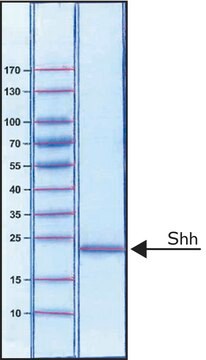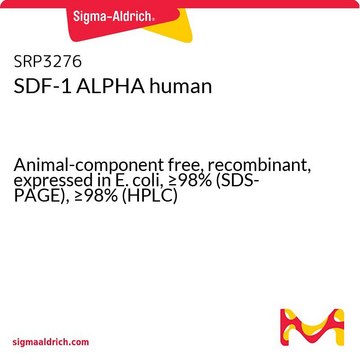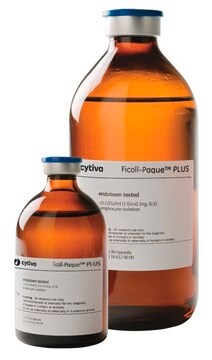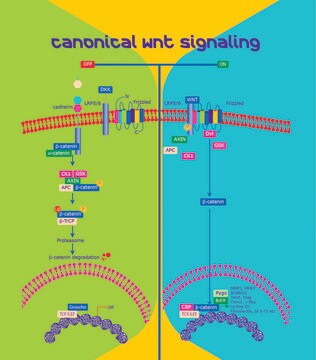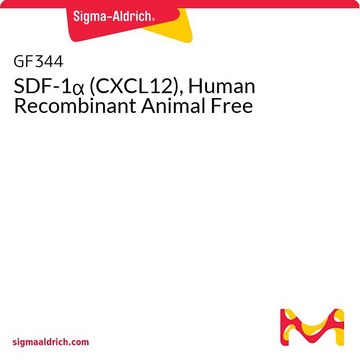GF174
Sonic HedgeHog (Shh) Protein, Human Recombinant
The hedgehog (hh) gene encoding a secreted protein was originally identified in Drosophila as a segment polarity gene.
Sinônimo(s):
SHH, HHG-1
Faça loginpara ver os preços organizacionais e de contrato
About This Item
Código UNSPSC:
12352202
eCl@ss:
32160405
NACRES:
NA.77
Produtos recomendados
Descrição geral
Product Source: E. coli.
The hedgehog (hh) gene encoding a secreted protein was originally identified in Drosophila as a segment polarity gene. The vertebrate homologues of hh comprise several proteins including sonic hedgehog (Shh), Indian hedgehog (Ihh), and Desert hedgehog (Dhh). Hedgehog proteins are important signaling molecules during embryonic development. Shh is expressed in key embryonic tissues such as the Hensen’s node, the zone of polarizing activity in the posterior limb bud, the notochord, and the floor plate of the neural tube. Shh is involved in regulating the patterning of the developing central nervous system, somite, and limb. Shh plays an important role in the development of particular tissues such as whisker, hair, foregut, tooth and bone. Evidence also suggests that Shh is involved in regulating stem cell fates of neural and hematopoietic lineages, and that aberrant Shh signaling is implicated in basal cell carcinomas and other diseases. Shh genes are highly conserved and have been identified in a variety of species including human, mouse, frog, fish, and chicken. Recombinant E. coli derived Human Sonic HedgeHog is a 20.0 kDa protein consisting of 176 amino acid residues, including an N-terminal Ile-Val-Ile sequence substituted for the natural occurring chemically modified Cys residue.
Especificidade
Cross Reactivty
None
None
Aplicação
Research Category
Stem Cell Research
Stem Cell Research
Research Sub Category
Growth Factors & Receptors
Growth Factors & Receptors
Qualidade
Bioactivity assay: Determined by its ability to induce alkaline phosphatase production by C3H/10T1/2 (CCL-226) cells. The expected ED50 for this effect is 0.8-1.0 μg/ml.
forma física
Product is filtered through a 0.2 micron filter before lyophilization.
Armazenamento e estabilidade
Store at -20°C for up to 6 months from date of receipt.
Exoneração de responsabilidade
Unless otherwise stated in our catalog or other company documentation accompanying the product(s), our products are intended for research use only and are not to be used for any other purpose, which includes but is not limited to, unauthorized commercial uses, in vitro diagnostic uses, ex vivo or in vivo therapeutic uses or any type of consumption or application to humans or animals.
Código de classe de armazenamento
11 - Combustible Solids
Classe de risco de água (WGK)
WGK 1
Ponto de fulgor (°F)
Not applicable
Ponto de fulgor (°C)
Not applicable
Certificados de análise (COA)
Busque Certificados de análise (COA) digitando o Número do Lote do produto. Os números de lote e remessa podem ser encontrados no rótulo de um produto após a palavra “Lot” ou “Batch”.
Já possui este produto?
Encontre a documentação dos produtos que você adquiriu recentemente na biblioteca de documentos.
Thais Basili et al.
International journal of cancer, 147(8), 2253-2264 (2020-05-10)
Hyalinizing trabecular tumors of the thyroid are rare and mostly benign epithelial neoplasms of follicular cell origin, which have recently been shown to be underpinned by the PAX8-GLIS3 fusion gene. In our study, we sought to investigate the potential oncogenic
Nossa equipe de cientistas tem experiência em todas as áreas de pesquisa, incluindo Life Sciences, ciência de materiais, síntese química, cromatografia, química analítica e muitas outras.
Entre em contato com a assistência técnica
